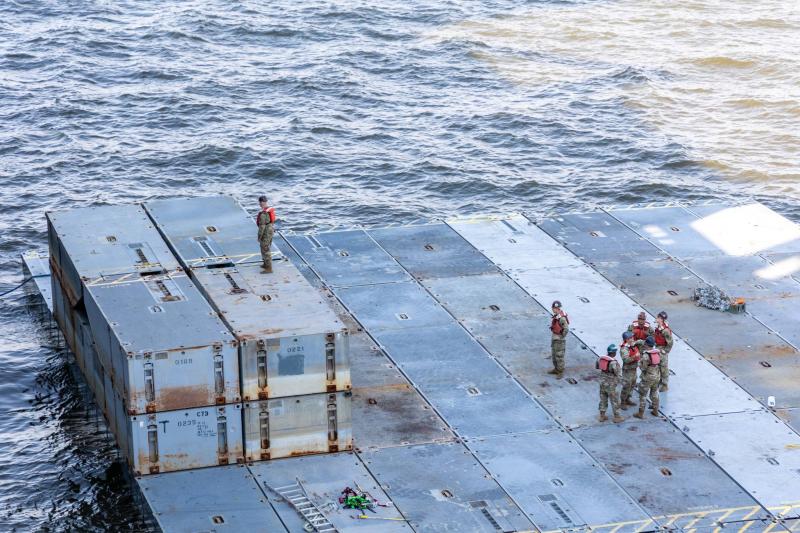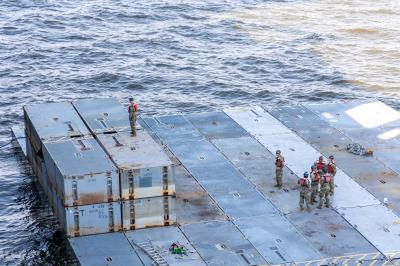The floating dock established by the United States, aimed at increasing the flow of humanitarian aid to the Gaza Strip, faced significant challenges and is now expected to be permanently dismantled. U.S. officials stated that they would attempt to reassemble the dock to alleviate the backlog of aid destined for Gaza in Cyprus before likely dismantling it permanently. Relief workers and others have long expressed skepticism about the project, asserting that "delivering aid overland is the only effective way to get supplies broadly into Gaza amid ongoing warfare."
### Details About the Dock
**Dock Construction**
President Joe Biden announced plans to build the dock in March following warnings of a potential famine throughout Gaza and increasing difficulties in sending aid through land crossings, which Israel had kept mostly closed for several months. Biden's announcement came as part of efforts to placate many in his Democratic Party who were angry at U.S. support for Israel in the war against Gaza. Since the escalation in Gaza began on October 7, the humanitarian situation for the 2.3 million residents has rapidly deteriorated. Almost all residents of the sector have been internally displaced, with many displaced multiple times.
**How the Dock Operates**
The floating dock is approximately 370 meters long, situated off the coast just north of the coastal wetlands in the Gaza Valley. Construction of the dock, which was partially assembled in the Israeli port of Ashdod, began in April, and the first aid delivery using it occurred on May 17. Food items and other supplies were transported to the dock from Cyprus, which led efforts to open a maritime route for humanitarian aid. The supplies were x-rayed in Cyprus in the presence of Israeli officials who closely monitored the aid entering Gaza, claiming it could benefit "Hamas." Supplies are then transferred to the dock by ships before being loaded onto trucks for transport to the shore. About 1,000 U.S. military personnel, some stationed at the dock, are involved in these complex steps. Estimates from the U.S. Department of Defense (Pentagon) suggest that costs in the first 90 days of operations through the dock could reach around $230 million.
**Challenges Faced by the Dock**
The dock has been temporarily removed several times due to high waves. On one occasion, it was pulled back to Ashdod for repairs. Shipments were also disrupted by delays in getting supplies into the Gaza Strip, a risky process requiring Israeli approvals. When considering the dock's return after bad weather in late June, U.S. officials indicated that there would be little immediate benefit, as the adjacent aid gathering area was nearly full. The United Nations World Food Program, responsible for overseeing the distribution of aid transported through the dock, halted its operations in June due to security concerns. Some relief workers expressed worries that the dock operated by the U.S. military could jeopardize staff and operations as local populations might doubt the neutrality of these individuals or suspect them of being spies. In June, the Pentagon sought to refute what it described as false reports on social media stating that Israel used the floating dock off Gaza for a hostage rescue mission.
### Volume of Aid Delivered
As of June 25, approximately 7,000 tons of aid had reached the Gaza Strip via Cyprus, according to U.S. officials involved in relief efforts, which is roughly equivalent to the cargo of 350 trucks. Aid officials state that "the Gaza Strip needs around 600 trucks daily carrying humanitarian and commercial supplies to meet the needs of the population." Before Israel expanded its military campaign to the city of Rafah in southern Gaza in early May, most aid entered the sector through the Rafah crossing with Egypt or the nearby Kerem Shalom crossing controlled by Israel. According to U.N. data, an average of 189 trucks entered through the two crossings in April. Several countries also delivered aid via airdrops, but this method can only be used to deliver a few tons at a time, which is far less than a truckload, and this approach can expose local populations to risks. A coalition of 25 NGOs stated in a March statement that nations should not exploit the pretext of airdrops of aid and maritime access "to create the illusion that they are doing enough to support the needs in Gaza."
### Future of the Floating Maritime Dock
There is a mandate for the floating maritime dock operations to continue until July 31. A senior U.S. official stated in June that "dock operations could be extended for at least one additional month." Pentagon officials warned that sea conditions and turbulence might not be suitable for the floating dock to operate after summer concludes.




